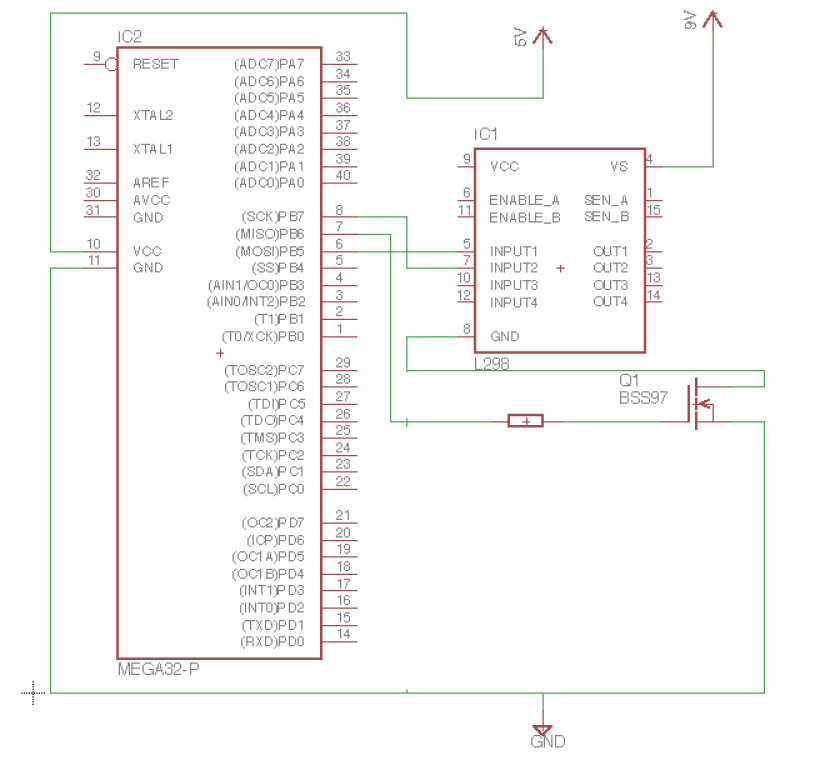Ok nevermind, I didnt plug in the 9V source, I had just left the USB connected to the computer so maybe it wasnt getting enough juice, which is btw why it should 4.85V or so, instead of the 8.45V.
I did discover however that a cleaned-up version of my code didnt work, seems the nano is reboots, maybe the wdt_reset() isnt reached in time, and so the runMotor() is never called. But with my old sleep code it works fine. So Id like to ask for help in cleaning up that failing code. Below are both code versions and both video links:
GOOD CODE======================================================
#include <avr/wdt.h> // library for default watchdog functions
#include <avr/interrupt.h> // library for interrupts handling
#include <avr/sleep.h> // library for sleep
#include <avr/power.h> // library for power control
#include <util/delay.h>
//1. DEFINE LED PIN FOR COND COMP
#if (defined (__AVR_ATmega328P__) || defined (__AVR_ATmega328__))
#define UNO
#define LED_PORT PORTB
#define LED_PIN PB5
char BOARD[] = {"m328p"};
#endif
//2. Defines variables
#define LED 13
#define fet 5
int nbr_sleeps=0;
int enA = 10;
int in1 = 7;
int in2 = 6;
inline void flash_led() {LED_PORT |= (1 << LED_PIN); _delay_ms(30);
LED_PORT &= ~(1 << LED_PIN);}
//3. Interrupt Service Routine - disable wdt as soon as comeback
ISR(WDT_vect){
// disables wdt upon wake up so it wont fire accidentally while we do stuff before sleep again
wdt_disable();
//does it get re-enabled by sleep_mode()? wdt_reset() might be a better idea.
}
//5. Set some other stuff up in setup
void setup(){
//5.1 L298N setup
pinMode(enA, OUTPUT);
pinMode(in1, OUTPUT);
pinMode(in2, OUTPUT);
pinMode(fet, OUTPUT);
digitalWrite(fet, LOW);
pinMode(LED, OUTPUT);
}
//6. These must be called each loop
void sleep(){
nbr_sleeps ++;
MCUSR &= ~(1<<WDRF); //or MCUSR = 0;
ADCSRA = 0; //turns off ADC
WDTCSR |= (1<<WDCE) | (1<<WDE); //or WDTCSR = bit (WDCE) | bit (WDE);
WDTCSR = 1<<WDP0 | 1<<WDP3;// or WDTCSR = bit (WDIE) | bit (WDP3) | bit (WDP0);
WDTCSR |= _BV(WDIE);
wdt_reset();
set_sleep_mode(SLEEP_MODE_PWR_DOWN);
noInterrupts();
sleep_enable();
// turn off brown-out enable in software
MCUCR = bit (BODS) | bit (BODSE);
MCUCR = bit (BODS);
interrupts(); // guarantees next instruction executed
sleep_mode();
flash_led();
//EXECUTION AFTER ISR RESUMES HERE...
sleep_disable();
}
void loop(){
flash_led(); //signalling about to sleep
sleep(); //sleep suff
if (nbr_sleeps==4) runMotor();
}
//8 sec/cycle * 450 cycles = 3600 seconds = 1hr
void runMotor() {
//Turn motor on
flash_led(); //signal about to run motor
//turn on mosfet
digitalWrite(fet, HIGH);
delay(500);
//Now run motor
digitalWrite(in1, HIGH);
digitalWrite(in2, LOW);
analogWrite(enA, 200);
delay(2000);
digitalWrite(in1, LOW);
digitalWrite(in2, LOW);
digitalWrite(fet, LOW);
nbr_sleeps=0;
}
BAD CODE=========================================================
#include <avr/wdt.h> // library for default watchdog functions
#include <avr/interrupt.h> // library for interrupts handling
#include <avr/sleep.h> // library for sleep
#include <avr/power.h> // library for power control
#include <util/delay.h>
//1. DEFINE LED PIN FOR COND COMP
#if (defined (__AVR_ATmega328P__) || defined (__AVR_ATmega328__))
#define UNO
#define LED_PORT PORTB
#define LED_PIN PB5
char BOARD[] = {"m328p"};
#endif
//2. Defines variables
#define LED 13
#define fet 5
int nbr_sleeps=0;
int enA = 10;
int in1 = 7;
int in2 = 6;
inline void flash_led() {LED_PORT |= (1 << LED_PIN); _delay_ms(30);
LED_PORT &= ~(1 << LED_PIN);}
//3. Interrupt Service Routine - disable wdt as soon as comeback
ISR(WDT_vect){
// disables wdt upon wake up so it wont fire accidentally while we do stuff before sleep again
wdt_disable();
//does it get re-enabled by sleep_mode()? wdt_reset() might be a better idea.
}
//4. Set WDT config parameters - ONCE
void configure_wdt(){
set_sleep_mode(SLEEP_MODE_PWR_DOWN);
MCUSR &= ~(1<<WDRF); //or MCUSR = 0;
ADCSRA = 0; //turns off ADC
power_adc_disable() //PRR extras
SPCR = 0; //turns off spi
power_spi_disable();// turns off clock to spi PRR extras
power_all_disable(); // PRR extras
WDTCSR |= (1<<WDCE) | (1<<WDE); //or WDTCSR = bit (WDCE) | bit (WDE);
WDTCSR = 1<<WDP0 | 1<<WDP3;// or WDTCSR = bit (WDIE) | bit (WDP3) | bit (WDP0);
WDTCSR |= _BV(WDIE);
}
//5. Set some other stuff up in setup
void setup(){
//5.1 L298N setup
pinMode(enA, OUTPUT);
pinMode(in1, OUTPUT);
pinMode(in2, OUTPUT);
pinMode(fet, OUTPUT);
digitalWrite(fet, LOW);
pinMode(LED, OUTPUT);
configure_wdt();
}
//6. Could maybe move some parameters, like ADC off back into the sleep()-loop()
void sleep(){
nbr_sleeps ++;
wdt_reset();
sleep_mode();
//EXECUTION AFTER ISR RESUMES HERE...
}
void loop(){
flash_led(); //signalling about to sleep
sleep(); //sleep suff
if (nbr_sleeps==4) runMotor();
}
//8 sec/cycle * 450 cycles = 3600 seconds = 1hr
void runMotor() {
//Turn motor on
flash_led(); //signal about to run motor
//turn on mosfet
digitalWrite(fet, HIGH);
delay(500);
//Now run motor
digitalWrite(in1, HIGH);
digitalWrite(in2, LOW);
analogWrite(enA, 200);
delay(2000);
digitalWrite(in1, LOW);
digitalWrite(in2, LOW);
digitalWrite(fet, LOW);
nbr_sleeps=0;
}
Video Links:
The bad video is similar but the led would blink before 8 seconds of sleep in one of the cycles, leading me to believe the Arduino was rebooted.






